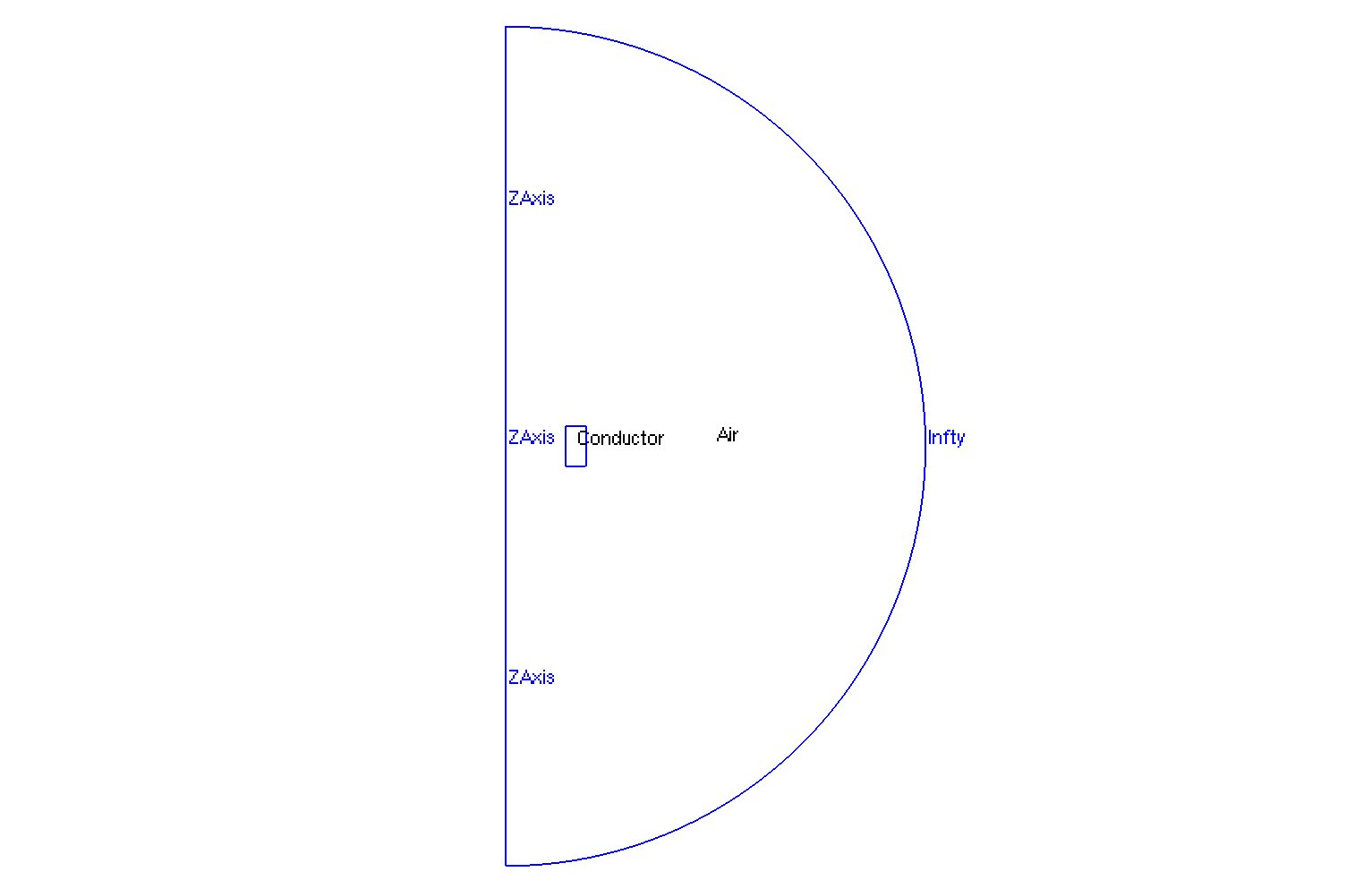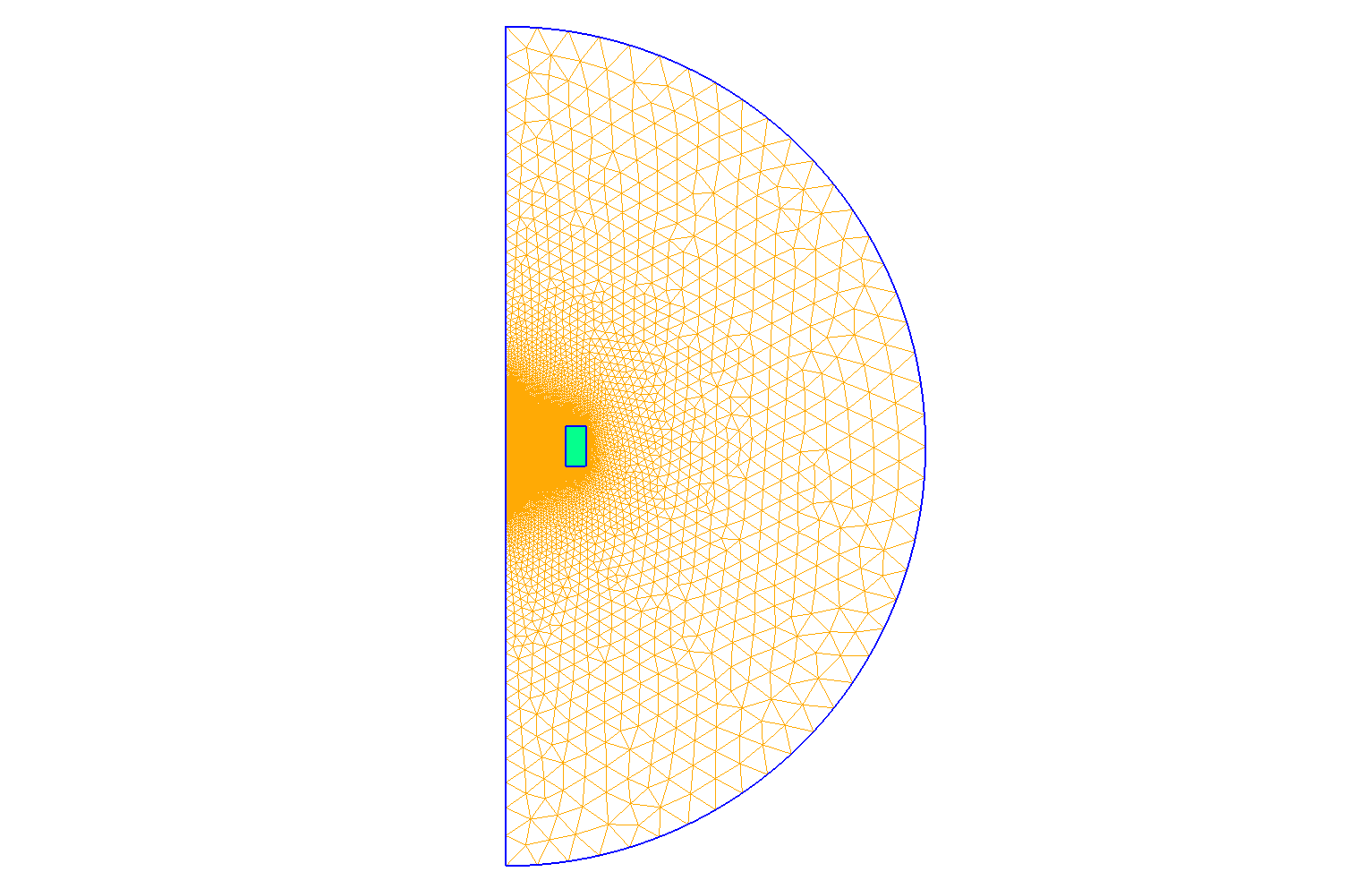Test Case of Thermo-Elasto-Magnetism in Transient Case and Axisymmetrical Coordinates
1. Introduction
This page presents the simulation and results of based on the theory Elastic Equations with Electromagnetism and Thermic in Axisymmetrical case : Elastic and Thermo-Electromagnetism problem coupled by Laplace Force and Thermal Dilatation in transient case and axisymmetric coordinates.
2. Run the calculation
The command line to run this case is :
mpirun -np 16 feelpp_toolbox_coefficientformpdes --config-file=elasto-thermo-mag.cfg --cfpdes.gmsh.hsize=5e-3
To compute with the Laplace Force and the Thermal Dilatation, please, put :
"bool_laplace":1,
"bool_dilatation":1,
in the Parameter section of the .json file elasto-thermo-mag.json.
This case run with the version 110 of Feelpp.
3. Data Files
The case data files are available in Github here :
-
CFG file - Edit the file
-
JSON file - Edit the file
-
GEO file - Edit the file
4. Equation
In this subsection, we couple the equation (Transient Elasticity Axis) of Elastic equation and (AV Axis) AV-Formulation in axisymmetric coordinates.
The domain of resolution of electromagnetism part is \(\Omega^{axis}\) with bounds \(\Gamma^{axis}\), \(\Gamma_D^{axis}\) the bound of Dirichlet boundary conditions and \(\Gamma_N^{axis}\) such that \(\Gamma^{axis} = \Gamma_N^{axis} \cup \Gamma_D^{axis}\).
The domain of resolution of elastic part is \(\Omega_c^{axis} \subset \Omega^{axis}\) (it’s also the domain of definition of electrical potential \(V\) and electrical conductivity \(\sigma\)) with bounds \(\Gamma_c^{axis}\), \(\Gamma_{D \hspace{0.05cm} elas}^{axis}\) the bound of Dirichlet conditions and \(\Gamma_{N \hspace{0.05cm} elas}^{axis}\) the bound of Neumann conditions such that \(\Gamma_c^{axis} = \Gamma_{D \hspace{0.05cm} elas}^{axis} \cup \Gamma_{N \hspace{0.05cm} elas}^{axis}\). The domain \(\Omega_c^{axis}\) is the conductor.
With :
|
|
|
|
|
|
|
And notations :
-
Divergence of tensor : \(\nabla \cdot \bar{\bar{\sigma}} = \begin{pmatrix} \nabla \cdot \bar{\bar{\sigma}}_{r,:} + \frac{\bar{\bar{\sigma}}_{rr} - \bar{\bar{\sigma}}_{\theta \theta}}{r} \\ \nabla \cdot \bar{\bar{\sigma}}_{z,:} + \frac{\bar{\bar{\sigma}}_{rz}}{r} \end{pmatrix}\)
-
Scalar produce of tensor : \(\bar{\bar{\sigma}} \cdot \mathbf{n} = \begin{pmatrix} \bar{\bar{\sigma}}_{r,:} \cdot \mathbf{n}^{axis} \\ \bar{\bar{\sigma}}_{z,:} \cdot \mathbf{n}^{axis} \end{pmatrix} = \begin{pmatrix} \bar{\bar{\sigma}}_{rr} \, n_r + \bar{\bar{\sigma}}_{rz} \, n_z \\ \bar{\bar{\sigma}}_{zr} \, n_r + \bar{\bar{\sigma}}_{zz} \, n_z\end{pmatrix}\)
We don’t care of geometrical deformation which can change the mesh or the density. We suppose the geometry is fixed.
5. Geometry
The geometry is a torus represented by a rectangle in axisymmetric coordinates \((r,z)\), surrounded by air.

Geometry in Axisymmetrical cut
|
The geometrical domains are :
-
Conductor: the torus is composed by conductor material-
Interior: interior surface of conductor ring -
Exterior: exterior surface of conductor ring -
Upper: upper of conductor ring -
Bottom: bottom of conductor ring
-
-
Air: the air surroundConductor-
zAxis: a bound ofAir, correspond to \(Oz\) axis (\(\{(z,r), \, z=0 \}\)) -
infty: the rest of bound ofAir
-
Symbol |
Description |
value |
unit |
\(r_{int}\) |
interior radius of torus |
\(75e-3\) |
m |
\(r_{ext}\) |
exterior radius of torus |
\(100.2e-3\) |
m |
\(z_1\) |
half-height of torus |
\(300e-3\) |
m |
\(r_{infty}\) |
radius of infty border |
\(5*r_{ext}\) |
m |
6. Boundary Conditions
We impose the boundary conditions :
-
Magnetic Equation :
-
Strong Dirichlet :
-
On
zAxis: \(\Phi = 0\) (\(A_{\theta} = 0\) by symmetric argument) -
On
infty: \(\Phi = 0\) (\(A_{\theta} = 0\) we consider the bound of resolution like infty for magnetic field)
-
-
-
Heat Equation :
-
Neumann : \(\frac{\partial T}{\partial \mathbf{n}} = 0\) on
InteriorandExterior -
Robin : \(-k \, \frac{\partial T}{\partial \mathbf{n}} = h \, \left( T - T_c \right)\) on
UpperandBottom. The Robin condition represents the cooling by water.
-
-
Elastic Equation :
-
Strong Dirichlet : \(\mathbf{u} = 0\) on
UpperandBottom. The Dirichlet condition represents the embedding of the mechanical part. -
Neumann : \(\bar{\bar{\sigma}} \cdot \mathbf{n} = 0\) on
InteriorandExterior. The Neumann condition represents the freedom of displacement.
-
On JSON file, the boundary conditions are written :
"BoundaryConditions":
{
"magnetic":
{
"Dirichlet":
{
"magdir":
{
"markers":["ZAxis","Infty"],
"expr":"0"
}
}
},
"heat":
{
"Robin":
{
"heatdir":
{
"markers":["Interior","Exterior"],
"expr1":"h*x:h:x",
"expr2":"h*T_c*x:h:T_c:x"
}
}
},
"elastic1":
{
"Dirichlet":
{
"elasdir":
{
"markers":["Upper","Bottom"],
"expr":"{0,0}"
}
}
}
}
7. Weak Formulation
We obtain :
8. Parameters
The parameters of problem are :
-
On
Conductor:
Symbol |
Description |
Value |
Unit |
\(V\) |
scalar electrical potential |
\( U \, \frac{\theta}{2\pi}\) |
\(Volt\) |
\(U\) |
electrical potential |
\(0.2\) |
\(Volt\) |
\(\sigma\) |
electrical conductivity at \(T=T_0\) |
\(58e6\) |
\(S/m\) |
\(j_{\theta}\) |
orthoradial current density |
\(- \sigma \frac{U}{2\pi} \, \frac{1}{r}\) |
\(A/m^2\) |
\(\rho\) |
density |
\(10000\) |
\(kg/m^3\) |
\(Cp\) |
thermal capacity |
\(380\) |
\(J/K/kg\) |
\(E\) |
Young Modulus |
\(2.1e6\) |
\(Pa\) |
\(\nu\) |
Poisson’s coefficient |
\(0.33\) |
\(dimensionless\) |
\(\lambda\) |
Lame’s coefficient |
\(\frac{E \, v}{(1-2v)(1+v)}\) |
\(Pa\) |
\(\mu\) |
Lame’s coefficient |
\(\frac{E}{2 (1+v)}\) |
\(Pa\) |
-
On
Air:
Symbol |
Description |
Value |
Unit |
\(\mu=\mu_0\) |
magnetic permeability of vacuum |
\(4\pi.10^{-7}\) |
\(kg \, m / A^2 / S^2\) |
On JSON file, the parameters are written :
"Parameters":
{
"bool_laplace":1,
"bool_dilatation":1,
"h":80000,
"T_c":293,
"T0":293,
"mu0":"4*pi*1e-7"
},
"Materials":
{
"Conductor":
{
"U":"0.2*t +(-0.2*t+0.2)*(t>1):t",
"sigma":58e+6,
"mu":"4*pi*1e-7",
"k":380,
"rho":10000,
"Cp":380,
"alpha_T":17e-6,
"E":2.1e6,
"nu":0.33,
"j_th":"-sigma*U/2/pi/x:sigma:U:x",
"Lame_lambda":"E*nu/(1-2*nu)/(1+nu):E:nu",
"Lame_mu":"E/(2*(1+nu)):E:nu",
"F_laplace":"{1/x*j_th*(magnetic_grad_Atheta_0*x+magnetic_Atheta),j_th*magnetic_grad_Atheta_1}:x:j_th:magnetic_Atheta:magnetic_grad_Atheta_0:magnetic_grad_Atheta_1",
"stress_T":"-(3*Lame_lambda+2*Lame_mu)*alphaT*(heat_T-T0):Lame_lambda:Lame_mu:alphaT:heat_T:T0",
"stress_rr":"(Lame_lambda+2*Lame_mu)*elastic1_grad_u_00+Lame_lambda/x*elastic1_u_0+Lame_lambda*elastic1_grad_u_11+bool_dilatation*stress_T:x:Lame_lambda:Lame_mu:elastic1_u_0:elastic1_grad_u_00:elastic1_grad_u_11:bool_dilatation:stress_T",
"stress_thth":"Lame_lambda*elastic1_grad_u_00+(Lame_lambda+2*Lame_mu)/x*elastic1_u_0+Lame_lambda*elastic1_grad_u_11+bool_dilatation*stress_T:x:Lame_lambda:Lame_mu:elastic1_u_0:elastic1_grad_u_00:elastic1_grad_u_11:bool_dilatation:stress_T",
"stress_zz":"Lame_lambda*elastic1_grad_u_00+Lame_lambda/x*elastic1_u_0+(Lame_lambda+2*Lame_mu)*elastic1_grad_u_11+bool_dilatation*stress_T:x:Lame_lambda:Lame_mu:elastic1_u_0:elastic1_grad_u_00:elastic1_grad_u_11:bool_dilatation:stress_T",
"stress_rz":"Lame_mu*(elastic1_grad_u_01+elastic1_grad_u_10):Lame_mu:elastic1_grad_u_01:elastic1_grad_u_10",
"stress1":"1/2.*(stress_rr + stress_rz) +sqrt((stress_rr-stress_zz)*(stress_rr-stress_zz)+4*stress_rz*stress_rz):stress_rr:stress_zz:stress_rz",
"stress2":"stress_thth:stress_thth",
"stress3":"1/2.*(stress_rr + stress_rz) -sqrt((stress_rr-stress_zz)*(stress_rr-stress_zz)+4*stress_rz*stress_rz):stress_rr:stress_zz:stress_rz"
},
"Air":
{
}
},
9. Coefficient Form PDEs
We use the application Coefficient Form PDEs. The coefficient associate to Weak Formulation are :
-
For MQS equation (Weak MQS Axis) :
-
On
Conductor:
Coefficient
Description
Expression
\(d\)
damping or mass coefficient
\(\sigma\)
\(c\)
diffusion coefficient
\(\frac{r}{\mu}\)
\(\beta\)
convection coefficient
\(\begin{pmatrix} \frac{2}{\mu} \\ 0 \end{pmatrix}\)
\(f\)
source term
\(j_{\theta} \, r^2\)
-
On
Air:
Coefficient
Description
Expression
\(c\)
diffusion coefficient
\(\frac{r}{\mu}\)
\(\beta\)
convection coefficient
\(\begin{pmatrix} \frac{2}{\mu} \\ 0 \end{pmatrix}\)
-
On JSON file, the coefficients are written :
"magnetic":{
"common":{
"setup":{
"unknown":
{
"basis":"Pch1",
"name":"Atheta",
"symbol":"Atheta"
}
}
},
"models":[
{
"name":"magnetic_Air",
"materials":"Air",
"setup":{
"coefficients":{
"c":"x/mu0:x:mu0",
"a":"1/mu0/x:x:mu0"
}
}
},
{
"name":"magnetic_Conductor",
"materials":"Conductor",
"setup":{
"coefficients":{
"c":"x/materials_Conductor_mu:x:materials_Conductor_mu",
"a":"1/materials_Conductor_mu/x:x:materials_Conductor_mu",
"f":"materials_Conductor_j_th*x:materials_Conductor_j_th:x",
"d":"materials_Conductor_sigma*x:x:materials_Conductor_sigma"
}
}
}
]
},
-
For heat equation, on
Conductor(the temperature isn’t computed onAir)
Coefficient |
Description |
Expression |
\(d\) |
damping or mass coefficient |
\(\rho \, C_p\) |
\(c\) |
diffusion coefficient |
\(k\) |
\(f\) |
source term |
\(- \sigma \left( \frac{U}{2\pi \, r} +\frac{\partial \Phi}{\partial t}\right)^2\) |
On JSON file, the coefficients are written :
"heat":{
"common":{
"setup":{
"unknown":
{
"basis":"Pch1",
"name":"temperature",
"symbol":"T"
}
}
},
"models":[
{
"name":"heat_Conductor",
"materials":"Conductor",
"setup":{
"coefficients":{
"c":"materials_Conductor_k*x:materials_Conductor_k:x",
"f":"materials_Conductor_sigma*materials_Conductor_U/(2*pi)*materials_Conductor_U/(2*pi)/x:materials_Conductor_sigma:materials_Conductor_U:x",
"d":"materials_Conductor_rho*materials_Conductor_Cp*x:materials_Conductor_rho:materials_Conductor_Cp:x"
}
}
}
]
},
-
For elastic equations, on
Conductor(the displacement and momentum aren’t computed onAir) :-
Displacement (elastic1) :
Coefficient
Description
Expression
\(d\)
damping or mass coefficient
\(r \rho \)
\(f\)
source term
\(\begin{pmatrix} r p_r \\ r p_z \end{pmatrix}\)
-
Momentum (elastic2) :
Coefficient
Description
Expression
\(\gamma\)
conservative flux source term
\(\begin{pmatrix}-r(\lambda+2\mu)\frac{\partial u_r}{\partial r}-\lambda u_r -r\lambda\frac{\partial u_z}{\partial z} & -r\mu(\frac{\partial u_r}{\partial z}\frac{\partial u_z}{\partial r})\\ -r\mu(\frac{\partial u_r}{\partial z}\frac{\partial u_z}{\partial r}) & -r\lambda\frac{\partial u_r}{\partial r}-\lambda u_r -r(\lambda+2\mu)\frac{\partial u_z}{\partial z} \end{pmatrix}\)
\(f\)
source term
\(\begin{pmatrix} r F_r - \lambda \frac{\partial u_r}{\partial r} - (\lambda+2\mu) \frac{u_r}{r} - \lambda \frac{\partial u_z}{\partial z} \\ r F_z \end{pmatrix}\)
-
On JSON file, the coefficients are written :
"elastic1":{
"common":{
"setup":{
"unknown":
{
"basis":"Pchv1",
"name":"displacement",
"symbol":"u"
}
}
},
"models":[
{
"name":"elastic1_Conductor",
"materials":"Conductor",
"setup":{
"coefficients":{
"d":"materials_Conductor_rho*x:materials_Conductor_rho:x",
"f":"{x*elastic2_v_0,x*elastic2_v_1}:x:elastic2_v_0:elastic2_v_1"
}
}
}
]
},
"elastic2":{
"common":{
"setup":{
"unknown":
{
"basis":"Pchv1",
"name":"speed",
"symbol":"v"
}
}
},
"models":[
{
"name":"elastic2_Conductor",
"materials":"Conductor",
"setup":{
"coefficients":{
"d":"x:x",
"gamma":"{-materials_Conductor_stress_rr*x,-materials_Conductor_stress_rz*x,- materials_Conductor_stress_rz*x, -materials_Conductor_stress_zz*x}:x:materials_Conductor_stress_rr:materials_Conductor_stress_rz:materials_Conductor_stress_zz",
"f":"{bool_laplace*x*materials_Conductor_F_laplace_0 - materials_Conductor_stress_thth,bool_laplace*x*materials_Conductor_F_laplace_1}:x:bool_laplace:materials_Conductor_F_laplace_0:materials_Conductor_stress_thth:materials_Conductor_F_laplace_1"
}
}
}
]
}
11. Result
11.1. Displacements
\(u_r(m)\)
|
\(u_z(m)\)
|
The radial displacement \(u_r\) is maximum on Or axis in the middle of the torus and decreases to zeros on Upper and Bottom.
The z-displacement is symmetric by Or axis. It is positive on the part and negative on the upper part on the interior side and negative on the part and positive on the upper part on the exterior side.
11.2. Tensor of Deformation \(\bar{\bar{\epsilon}}\)
\(\bar{\bar{\epsilon}}_{rr} = \frac{\partial u_r}{\partial z}\)
|
\(\bar{\bar{\epsilon}}_{\theta \theta} = \frac{1}{r} \, u_r\)
|
\(\bar{\bar{\epsilon}}_{zz} = \frac{\partial u_z}{\partial z}\)
|
\(\bar{\bar{\epsilon}}_{rz} = \frac{1}{2} \left( \frac{\partial u_r}{\partial z} + \frac{\partial u_z}{\partial r} \right)\)
|
The r-deformation is uniform by z. It is maximal on the middle radius.
The theta-deformation is maximal in Or axis near the interior of the torus and decrease to negative near Upper and Bottom.
The z-deformation is symmetric by the Or axis in the middle of the torus.
The rz-shear is positive on Upper and negative on Bottom.
11.3. Stress Tensor \(\bar{\bar{\sigma}}\)
\(\scriptsize{\bar{\bar{\sigma}}_{rr} = \frac{\lambda}{r} \, u_r + \left( \lambda + 2\mu \right) \, \frac{\partial u_r}{\partial r} + \lambda \, \frac{\partial u_z}{\partial z} - (3\lambda + 2\mu) \, \alpha_T \, \left(T-T_0\right) (Pa)}\)
|
\(\scriptsize{\bar{\bar{\sigma}}_{\theta \theta} = \frac{\lambda + 2\mu}{r} \, u_r + \lambda \, \frac{\partial u_r}{\partial r} + \lambda \, \frac{\partial u_z}{\partial z}- (3\lambda + 2\mu) \, \alpha_T \, \left(T-T_0\right) (Pa)}\)
|
\(\scriptsize{\bar{\bar{\sigma}}_{zz} = \frac{\lambda}{r} \, u_r + \lambda \, \frac{\partial u_r}{\partial r} + \left( \lambda + 2\mu \right) \, \frac{\partial u_z}{\partial z} - (3\lambda + 2\mu) \, \alpha_T \, \left( T-T_0 \right) (Pa)}\)
|
\(\bar{\bar{\sigma}}_{rz} = \mu \, \left( \frac{\partial u_r}{\partial z} + \frac{\partial u_z}{\partial r} \right) (Pa)\)
|
The radial stress is uniform by the Oz axis and the minimum is reached in the middle.
The orthoradial stress is uniform by the Or axis and the minimum is also reached in the middle.
The z-deformation near of the center is symmetric by Or axis.
The rz-shear is positive on Upper and negative on Bottom.
11.4. Other Tensor
11.4.1. Criterion of Von Mises \(\bar{\bar{\sigma}}_{vm}\)
The tensor of Von Mises permits to say if the matters is in elastic state or not. If the tensor exceeds an matter’s parameter, the matter pass to elastic state to plastic state.
The \(\sigma_i\) are the principles tensors, the eigenvalues of stress tensor \(\bar{\bar{\sigma}}\).
12. References
-
Elasticity adn toolbox Coefficient Form PDEs, Céline Van Landeghem, 2021, unpublished, Download the PDF
-
Coupled modelling and simulation of electromagnets in stationnary and instationnary modes (axisymmetric and 3D), J. Nadarasa, June 2 2015, unpublished, page 20-24.
-
Theorical Physics Reference, Ondřej Čertík, November 29 2011, page 85-90.
